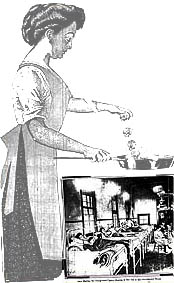|
Click
here to read the Discovery of Typhoid
Mary.pdf
The
Capture of Typhoid Mary
In
1907 Sara Josephine Baker, a physician and New Your City medical
inspector, was dispatched to visit Mary Mallon, the famous cook
who became known as "Typhoid Mary." George Soper at the [New York
City] Department of Health Laboratories had investigated seven
family epidemics of typhoid going back to 1900. He found that
they were all linked to the cook in each family. Baker was sent
to collect specimens for culture. On her first visit, Baker had
the door slammed in her face. The next day, when she returned
with several policemen, Mary answered the door and against tried
to slam it shut, but a policeman's food was in the door. Mary
ran into the house and could not be found in a search of the house.
But looking out the rear window, Dr. Baker noticed a chair against
the fence and footprints in the snow. Mary was found next door
hiding in a closet. She was most uncooperative and fought against
having blood taken so she was forcibly transported in an ambulance
to a hospital where specimens were obtained. The blood and urine
cultures were negative but the stool culture was teaming with
typhoid bacilli. Captured on March 20, 1907, Mary Mallon was confined
to Willard Parker Hospital for two years and 11 months during
which time every available remedy was tried to rid her of the
typhoid organisms., All efforts failed. On the promise that she
would return every three months to the laboratory and take up
some occupation other than cooking, Mary was released. She promptly
disappeared.
For
the next five years Mary worked in homes and institutions in and
around New York, often under assumed names. In February 1915,
a devastating outbreak of typhoid (1,300 reported cases) was traced
to her. She was apprehended and made no struggle against the second
capture. This time she was sent to North Brother Island where
she remained for 23 years, to the end of her life in 1938, a special
guest of New York City.
Discussions
of the ethics of her case, the morality of depriving her of liberty,
had commenced at the annual meeting of the American Medical Association
in Chicago in 1910. Concurrently there was consternation of the
probability that many more typhoid carriers must be at liberty
in many communities.
Sources: O'Hern,
E. M. "Sara Josephine Baker." In Profiles of Women
Scientists. Washington, D.C.: Acropolis Books, 1985.
Bourdain,
Anthony. Typhoid Mary: An Urban Historical. New York
City: Bloomsbury, 2001.
|
 |